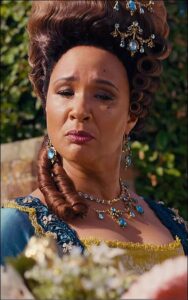
It’s no secret that Bridgerton, and its spinoff series, Queen Charlotte: A Bridgerton Story, focus heavily on the ideas of marriage and, more illusively, love. Among the people of the ton, there are discussions of the rarity of love matches, but the show has given plenty of examples. Already the world of Bridgerton is full of couples, Daphne and Simon, Anthony and Kate, Charlotte and George, Violet and her late husband Edmond, and many more. Beyond their love, all of these pairs have one thing in common. They are examples of heterosexual romance. And, on the whole, that’s all Bridgerton has. Although referenced in Benedict’s (Luke Thompson) plot, no major characters have had a queer love story. In fact, the brief moments seen in Bridgerton are not enough to even be an independent side plot.
Yet that changed with Queen Charlotte. Although the series mainly follows Charlotte (India Amarteifio) and George (Corey Mylchreest) in the early years of their marriage, they are far from the only love story featured. Lady Agatha Danbury (Arsema Thomas) gets one, as does Charlotte’s shadow, Brimsley (Sam Clemmett). Introduced in Bridgerton, little was known about the older Brimsley (Hugh Sachs), yet Queen Charlotte remedies that with a backstory, as well as fixing the utter lack of queer romance. Brimsley has a relationship with the King’s valet, Reynolds (Freddie Dennis), making them the first homosexual love story in the Bridgerton universe. Although their romance isn’t public knowledge, the show does a phenomenal job of building it without being performative. Admittedly, this is only one example and isn’t enough to even out the representation. But including Brimsley and Reynolds’ story is a first step, hopefully opening the door to more queer characters in the franchise’s future.

Brimsley and Reynolds in ‘Queen Charlotte’
The romance fits into the story seamlessly, as both characters are a large part of the story independently. Brimsley is chosen to be Charlotte’s right-hand man before she arrives, never more than a few paces behind her, he necessarily becomes a large part of her life, and she quickly grows to trust him as he helps her bend the rules. Brimsley instructs Charlotte on how things work with the royal family once she learns to listen to him. The two develop a friendship, though their respective positions make it difficult. On the other hand, Reynolds is the King’s valet. Like Brimsley, he is always close to George. Reynolds is a trusted confidant of George’s as well. He helps to conceal the King’s madness, refuses to let secrets slip, even to Brimsley. As significant characters, their romance is more than checking a representation box. Allowing them a side plot gives the characters more personality than the stoic shadows of the king and queen. And the conversations during their tries help to disperse information about Charlotte and George’s plot.
The two men are dedicated to their work but meet in secret, when possible, establishing their own romance. When George and Charlotte are alone, they can sneak off together for their own relationship. The show doesn’t detail the beginning of this romance, but it certainly grows on-screen. As Charlotte and George spend more time together, Brimsley and Reynolds get the same luxury. Their positions mean as long as the king and queen remain united and happy, they can be together almost constantly without suspicion, a rare and fortunate circumstance for a gay couple in this time period. When Charlotte and George fall in love, Brimsley and Reynolds are able to realistically contemplate growing old together. Their faces difficulties as Reynolds must lie to Brimsley to keep George’s secret. But they manage to work it out, and their younger versions are seen for the last time dancing together, slightly removed from the royal party. Although not a leading storyline, these characters fill in the representation with a relevant and meaningful love story.
